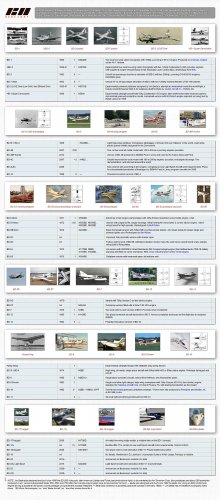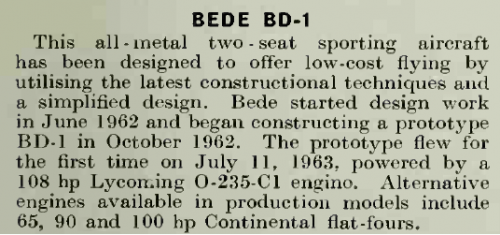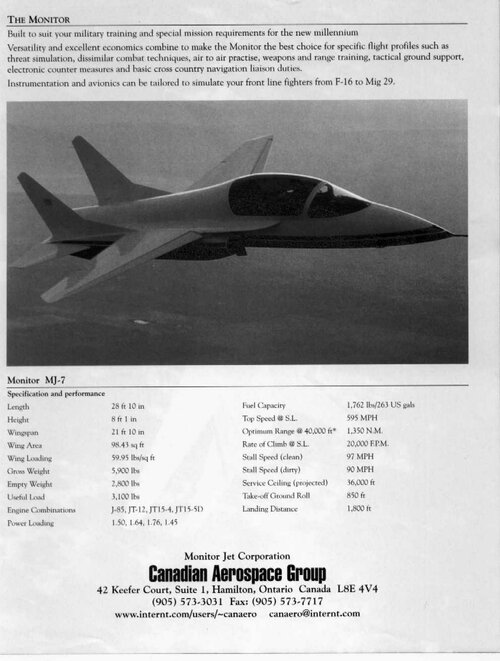- Joined
- 28 January 2008
- Messages
- 635
- Reaction score
- 512
With the recent death of Jim Bede I thought it might be a good time to finish off an on going list of designs.
James R. "Jim" Bede (b.April 17, 1933 d.July 9, 2015) was an American aircraft designer. He designed well over a dozen aircraft from the 1960s. A string of business failures kept most of these designs out of widespread use. Many kits were produced over the years as he became best know as a plans provider for home builders.
Some of his designs had unusual features (BD-5 and XDB-2) and brought him to attention, although not to the extent of contemporary designers such as Bert Rutan.
BD-1
Low-wing side-by-side two-seat aircraft which was developed into the American Aviation AA-1 Yankee. Low cost all-metal design. Powered by Continental A65-8 (65 hp) engine. Prototype was N624BD, c/n of 02, and first flight was 11th July 1963.
BD-2
Long-range record chasing aircraft based on the Schweizer 232 airframe. Named 'Love One' (Low Orbit Very Effecient). Powered by Continental IO-360 (210 hp) engine. Prototype registered N1982A and first flight was in April 1966. (see also http://www.secretprojects.co.uk/forum/index.php/topic,6189.msg51096.html#msg51096)
BD-3
Project only. Was to be the production six-seat based on the XBD-2 design. Retractable undercarriage.
BD-4
High-wing two-seat kit built aircraft with tail or nose wheel undercarriage options which first flew in 1968. It had a slab-sided fuselage. Powered initially by a Lycoming O-235 (108 hp). Over 700 built by self-build owners. Prototype registered N624BD.
BD-4B
Redesigned wing with tubular main spar.
BD-4C
Four seat development of the BD-4 design. Later kits had an avionic option to buy. At least one fitted with a diesel engine.
BD-5
Single-seat many fitted with a Xenoah (70 hp) pusher engine with propeller after the original Hirth engine ceased production. Named 'Bede Micro'. Prototype had a small V-tail, soon replaced by a conventional vertical fin and tail plane. It had retractable undercarriage. Prototype registered N500BD and the maiden flight was on 12th September 1971.
BD-5A
Short wing variant with HKS-700 (60 hp) engine or Liekhaefer Aeromarine 40hp engine.
BD-5B
Longer wing variant with HKS-700 (60 hp) or Hirth (70 hp) engine.
BD-5C
Aerobatic version with short wing span.
BD-5D
Factory-built version of the BD-5B. The certified production model, many kits sold but no record found of any actually being completed to flying status.
BD-5G
Fitted with a Rotax 912 S (100 hp) or Xenoah 3 cylinder (70 hp) engine. Two built in Austria as OE-VCF and OE-CBD.
BD-5J
Jet powered version with Microturbo TRS-18 turbojet and a 17 ft wingspan.
BD-5S
Sailplane version from 1975 with increased span, not successful.
BD-5T
Proposed turboprop version (fitted with a Solar T-62 APU?)
BD-6
Single-seat high-wing version of the BD-4 design. Available as a kit in 2013, first example N6BD.
BD-7 (1)
Powered by two 290 hp engines, similar to the XDB-2. Not completed and designation reused.
BD-7 (2)
Development of the BD-5 with four seats. Only one example, N7BD (first flew December 1976), built with a 100 hp engine. FAA records show c/n 7-0001, but license marked as "revoked" (no date). Certificate issue date of 3/13/75 was a pre-registration, so it is entirely possible the aircraft was not completed despite reports that it had flown.
BD-8
Single-seat low-wing aerobatic and sports aeroplane. Only two built in the mid-1970's by homebuilders who finished of work initially began by Bede before bankruptcy. It was a tail-dragger.
BD-9
Prototype only from 1983. A high-wing, single-seat ultra light, named 'Super Demoiselle'. Single-seat aircraft with a Cuyuna 430-2UL two-stroke (35hp) engine.
BD-10
Side-by-side two-seat jet with a delta wing and General Electric J-85 powerplant. Distinctive twin tail fins. Prototype was N2BD and first flew July 1992. Five kits flown, three crashed. In December 1993 the entire BD-10 project was taken over by the Fox-10 Corp., intending to produce completed versions of the design under the name Fox-10 (Peregrine Falcon).
BD-10J
Project proposal to compete in the 1991-93 JPATS competition. It was similar to the Northrop T-38, but much smaller and used only a single engine. The Williams FJ44 and Pratt & Whitney JT12 engines were also offered as options.(see http://www.secretprojects.co.uk/forum/index.php/topic,733.msg118860.html#msg118860)
BD-11
An unbuilt project for a six-seat version of the BD-5 design. A light aircraft project, a derivative of the BD-10, but powered by one Williams FJ-44-1turbofan engine.
BD-12
Project from 1995 for a side-by-side seat version of the BD-5 design. Registration N112BD allocated but only prototype built. Crashed during maiden flight which was undertaken with lead in the nose to rectify a tail heavy centre of gravity.
BD-12A
An unbuilt twin seat variant with 80 hp engine.
BD-12B
An nbuilt twin seat variant with 100 hp engine.
BD-12C
Unbuilt twin seat variant with 150 hp engine with a maximum speed of 215 mph.
BD-13
Designation not used.
BD-14
Another unbuilt project based on the uncompleted BD-12 project with four seats and good panoramic views from inside. Also some sources indication that this design may have been proposed as a light fighter (?).
BD-14A
Unbuilt variant with 150 hp engine.
BD-14B
Unbuilt variant with 260 hp engine.
BD-14C
Unbuilt variant with 350 hp turbocharged engine with a top speed of 305 mph.
BD-15
Project only.
BD-16
A 1998 Project developed from the earlier BD-4 with six seats.
BD-17
Low-wing, single-seat design with a HKS 700E (60 hp) engine. Named 'Nugget'. Jabiru (120 hp) engine also an option. Metal high-performance aircraft with claimed unmatched range and speed. First example was N624BD and the maiden flight was on 11th February 2001.
BD-17L
Light sport aircraft (LSA) variant from 2014.
BD-18
Twin-seat development of the BD-17. Low-wing, single-engine tourer with fixed, spatted, undercarriage. Could be fitted with various 120 hp to 180 hp engines by homebuilders.
BD-19
Project only. More details required.
BD-20
Project only. More details required.
BD-21
Project only. More details required.
BD-22
The first BD-22 example built was N224BD which first flew in March 2015. Two-seat development of the BD-17 with a 47 inch wide cockpit. Fatal crash 1st April 2015.
BD-22L
Two-seat light sport version of the BD-17 first shown publically in January 2015 as N224BD. Powered by Lycoming O-235 (118 hp) engine. Composite fuselage, metal wings and tricycle undercarriage.
XBD-2
Experimental STOL laminar flow research aircraft registered N327BD. Installed with two Continental O-300 (145 hp) pusher engines. Maiden flight 26th July 1961.
HB-1
Registered N590AS, first flew in July 1966, named 'Demoiselle'. It had a Continental A65 engine and originally had an open cockpit.
Bede-Wing
Hang glider from 1974 made up of an aerial wing of inflatable material (Patent issued 1974). Partly inflated by lighter than air gas and the rest inflated by air during flight. Shroud lines used to suspend a person beneath the aerofoil during flight. At least one completed.
Litestar
Flying car hybrid project which emerged as a motor cycle.
Source:
Aerofiles website (http://www.aerofiles.com/_ba.html)
Air Britain Digest (September 2015)
Bede Corp website (http://www.bedecorp.com & https://www.facebook.com/bedecorp)
http://www.secretprojects.co.uk/forum/index.php/topic,2324.msg247831.html#msg247831
James R. "Jim" Bede (b.April 17, 1933 d.July 9, 2015) was an American aircraft designer. He designed well over a dozen aircraft from the 1960s. A string of business failures kept most of these designs out of widespread use. Many kits were produced over the years as he became best know as a plans provider for home builders.
Some of his designs had unusual features (BD-5 and XDB-2) and brought him to attention, although not to the extent of contemporary designers such as Bert Rutan.
BD-1
Low-wing side-by-side two-seat aircraft which was developed into the American Aviation AA-1 Yankee. Low cost all-metal design. Powered by Continental A65-8 (65 hp) engine. Prototype was N624BD, c/n of 02, and first flight was 11th July 1963.
BD-2
Long-range record chasing aircraft based on the Schweizer 232 airframe. Named 'Love One' (Low Orbit Very Effecient). Powered by Continental IO-360 (210 hp) engine. Prototype registered N1982A and first flight was in April 1966. (see also http://www.secretprojects.co.uk/forum/index.php/topic,6189.msg51096.html#msg51096)
BD-3
Project only. Was to be the production six-seat based on the XBD-2 design. Retractable undercarriage.
BD-4
High-wing two-seat kit built aircraft with tail or nose wheel undercarriage options which first flew in 1968. It had a slab-sided fuselage. Powered initially by a Lycoming O-235 (108 hp). Over 700 built by self-build owners. Prototype registered N624BD.
BD-4B
Redesigned wing with tubular main spar.
BD-4C
Four seat development of the BD-4 design. Later kits had an avionic option to buy. At least one fitted with a diesel engine.
BD-5
Single-seat many fitted with a Xenoah (70 hp) pusher engine with propeller after the original Hirth engine ceased production. Named 'Bede Micro'. Prototype had a small V-tail, soon replaced by a conventional vertical fin and tail plane. It had retractable undercarriage. Prototype registered N500BD and the maiden flight was on 12th September 1971.
BD-5A
Short wing variant with HKS-700 (60 hp) engine or Liekhaefer Aeromarine 40hp engine.
BD-5B
Longer wing variant with HKS-700 (60 hp) or Hirth (70 hp) engine.
BD-5C
Aerobatic version with short wing span.
BD-5D
Factory-built version of the BD-5B. The certified production model, many kits sold but no record found of any actually being completed to flying status.
BD-5G
Fitted with a Rotax 912 S (100 hp) or Xenoah 3 cylinder (70 hp) engine. Two built in Austria as OE-VCF and OE-CBD.
BD-5J
Jet powered version with Microturbo TRS-18 turbojet and a 17 ft wingspan.
BD-5S
Sailplane version from 1975 with increased span, not successful.
BD-5T
Proposed turboprop version (fitted with a Solar T-62 APU?)
BD-6
Single-seat high-wing version of the BD-4 design. Available as a kit in 2013, first example N6BD.
BD-7 (1)
Powered by two 290 hp engines, similar to the XDB-2. Not completed and designation reused.
BD-7 (2)
Development of the BD-5 with four seats. Only one example, N7BD (first flew December 1976), built with a 100 hp engine. FAA records show c/n 7-0001, but license marked as "revoked" (no date). Certificate issue date of 3/13/75 was a pre-registration, so it is entirely possible the aircraft was not completed despite reports that it had flown.
BD-8
Single-seat low-wing aerobatic and sports aeroplane. Only two built in the mid-1970's by homebuilders who finished of work initially began by Bede before bankruptcy. It was a tail-dragger.
BD-9
Prototype only from 1983. A high-wing, single-seat ultra light, named 'Super Demoiselle'. Single-seat aircraft with a Cuyuna 430-2UL two-stroke (35hp) engine.
BD-10
Side-by-side two-seat jet with a delta wing and General Electric J-85 powerplant. Distinctive twin tail fins. Prototype was N2BD and first flew July 1992. Five kits flown, three crashed. In December 1993 the entire BD-10 project was taken over by the Fox-10 Corp., intending to produce completed versions of the design under the name Fox-10 (Peregrine Falcon).
BD-10J
Project proposal to compete in the 1991-93 JPATS competition. It was similar to the Northrop T-38, but much smaller and used only a single engine. The Williams FJ44 and Pratt & Whitney JT12 engines were also offered as options.(see http://www.secretprojects.co.uk/forum/index.php/topic,733.msg118860.html#msg118860)
BD-11
An unbuilt project for a six-seat version of the BD-5 design. A light aircraft project, a derivative of the BD-10, but powered by one Williams FJ-44-1turbofan engine.
BD-12
Project from 1995 for a side-by-side seat version of the BD-5 design. Registration N112BD allocated but only prototype built. Crashed during maiden flight which was undertaken with lead in the nose to rectify a tail heavy centre of gravity.
BD-12A
An unbuilt twin seat variant with 80 hp engine.
BD-12B
An nbuilt twin seat variant with 100 hp engine.
BD-12C
Unbuilt twin seat variant with 150 hp engine with a maximum speed of 215 mph.
BD-13
Designation not used.
BD-14
Another unbuilt project based on the uncompleted BD-12 project with four seats and good panoramic views from inside. Also some sources indication that this design may have been proposed as a light fighter (?).
BD-14A
Unbuilt variant with 150 hp engine.
BD-14B
Unbuilt variant with 260 hp engine.
BD-14C
Unbuilt variant with 350 hp turbocharged engine with a top speed of 305 mph.
BD-15
Project only.
BD-16
A 1998 Project developed from the earlier BD-4 with six seats.
BD-17
Low-wing, single-seat design with a HKS 700E (60 hp) engine. Named 'Nugget'. Jabiru (120 hp) engine also an option. Metal high-performance aircraft with claimed unmatched range and speed. First example was N624BD and the maiden flight was on 11th February 2001.
BD-17L
Light sport aircraft (LSA) variant from 2014.
BD-18
Twin-seat development of the BD-17. Low-wing, single-engine tourer with fixed, spatted, undercarriage. Could be fitted with various 120 hp to 180 hp engines by homebuilders.
BD-19
Project only. More details required.
BD-20
Project only. More details required.
BD-21
Project only. More details required.
BD-22
The first BD-22 example built was N224BD which first flew in March 2015. Two-seat development of the BD-17 with a 47 inch wide cockpit. Fatal crash 1st April 2015.
BD-22L
Two-seat light sport version of the BD-17 first shown publically in January 2015 as N224BD. Powered by Lycoming O-235 (118 hp) engine. Composite fuselage, metal wings and tricycle undercarriage.
XBD-2
Experimental STOL laminar flow research aircraft registered N327BD. Installed with two Continental O-300 (145 hp) pusher engines. Maiden flight 26th July 1961.
HB-1
Registered N590AS, first flew in July 1966, named 'Demoiselle'. It had a Continental A65 engine and originally had an open cockpit.
Bede-Wing
Hang glider from 1974 made up of an aerial wing of inflatable material (Patent issued 1974). Partly inflated by lighter than air gas and the rest inflated by air during flight. Shroud lines used to suspend a person beneath the aerofoil during flight. At least one completed.
Litestar
Flying car hybrid project which emerged as a motor cycle.
Source:
Aerofiles website (http://www.aerofiles.com/_ba.html)
Air Britain Digest (September 2015)
Bede Corp website (http://www.bedecorp.com & https://www.facebook.com/bedecorp)
http://www.secretprojects.co.uk/forum/index.php/topic,2324.msg247831.html#msg247831



